Note: vibrato/tremelo arm and single coil pickups
A True History of JB's Cream basses
by Graeme Pattingale with Bob Elliott.
Jack's Cream basses are not the subject of legends however the chronology needs clarifying. The technical reasons for the choice of the basses are also interesting.
Note: vibrato/tremelo arm and single coil pickups
Jack did take guitar like solos with the Graham Bond Organisation as they had no guitarist |
1. 1966-67 1961(?)Fender VI (quickly renamed Bass VI) , 3 switch, Sunburst. Jack moved from his white acoustic double bass to this bass in 1964 during the Graham Bond Organisation days. Technically this was a baritone guitar ie halfway between a standard bass and a guitar thus the 3 pickups and vibrato (vibrato tailpiece is from the Jazzmaster guitar), which Jack removed. It also used lighter string gauges than a bass but heavier than a guitar. To use as a bass it was just a matter of appropriate tuning ie to a four string with two added high strings. |
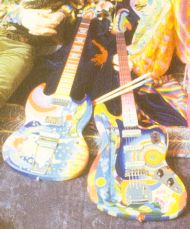 This was painted by the Fool for the Murray the K show. (Note: knobs not yet refitted to EC's guitar) |
WHY?: Jack went from an acoustic or double bass to this unusual and unsuccessful electric bass. Partly he liked the sound but also the lighter strings allowed him to achieve his incredible dexterity. It was tuned as a bass but in reality he played it as if it was a guitar. Jack never gave Cream that heavy bottom end as he combined the role of bass and quasi rhythm guitar player.
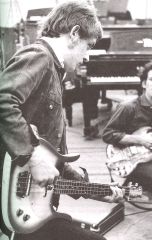 |
2 : March 1967 The Fender had been painted for the Murray the K show and paint had got into the electrics resulting in Jack buying new basses when he arrived in NY. He chose a midscale Danelectro Longhorn with 24 frets as opposed to 21 of the Fender. This was a budget bass produced to a price (it used a wooden saddle bridge!) and mainly sold via mail through the Sears Catalogue. They were a good design, quite well made while being cheap - Jack bought two. He continued playing them because he didn't like the painted Bass VI, though he used it for TV appearances. |
|
WHY?: Probably he couldn't get another Bass VI on such short notice as it was out of production. The Danelectro, while having an extended scale, also used the mid gauge strings. Jack could get a slighly heavier sound but still retained that dextrous fretwork. The difference is clearly heard on Disraeli Gears.
| 3. July 1967+ 1961 Gibson EB-3, 3 way toggle switch, cherry red (EB3#1) [presumably the 1st as it was an older model]. This is an unusual model as it has a 3 way toggle switch (like the 2 pickup EB6), rather than the 4 way knob, and a string damper indicating that it was probably an early production model. The switch selected each pickup or both with Jack preferring the the mini-humbucking bridge pickup which was heavily overdriven, producing the growling sound. The humbucking neck cover is lipped and is actually silver painted plastic. An unlipped chromed metal cover was introduced from 1963. The Gibson EB3 is a short scale bass of 30.5" vs standard 34" and has 20 frets. Jack continued to use light gauge strings - La Bella brand. While the Danelectro was used on White Room the rest of Wheels of Fire is the EB-3 noteably "Sitting on Top of the World" of which the basic tracks were laid down in July. For the US tour he had a 2nd 1961-63 EB-3 but with standard 4 way switch and narrow skirted knobs(EB-3#2)[Live Cream Vol II cover at the Fillmore Aug/Sept '67]. The 4 way switch had an extra 'baritone' setting for the neck pickup.
3-Way toggle switch, narrow skirted knobs, lipped cover on neck pickup |
|
He continued to carry the Bass VI as he plays it on "Sleepy Time Time" at the November Konserthusert gig and used it in promo pictures in February 1968. The Bass VI is now believed to be in the possession of Leslie West.
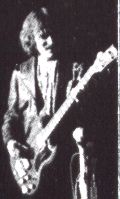 |
4. Feb-June 1968 tour Jack continued to use both EB-3s but as the tour progressed the 3 way became the spare. Another 4 way was added as another spare - the one used on Summers Bros show with the wider skirted calibrated knobs and metal pickup cover on the neck humbucking (EB-3#3 - 1963+). |
|
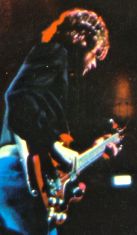 |
5. Final 1968 tour EB-3#3 with white Fender guitar knobs. The Bruce Gary bass is most probably EB-3#3 despite its different bridge (a bar bridge without the string damper). Dan Armstrong modified by adding the diode to retain/accentuate the "bumblebee" sound when not using the Marshall Stacks. |
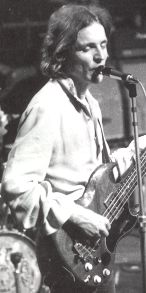 |
WHY?: The Gibson EB3 was not a very successful bass though Jack helped sell a lot in 68-69. It was a short scale but used standard guage bass strings, however Jack replace them with light gauge bass strings. The shorter scale meant lower string tension and coupled with the lighter strings, Jack retained that dextrous fretwork. Its lack of real bass depth limited its popularity but it suited Jack especially with the Marshall Stacks. Phil Lesh of the Grateful Dead took it up in 68-69 and, notably, is heard on the classic "Live Dead".
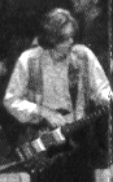
Phil Lesh, Feb 1969
& note the large humbucking instead of the mini on the bridge
Copyright © Graeme Pattingale 2001(Corrected Feb 2001)